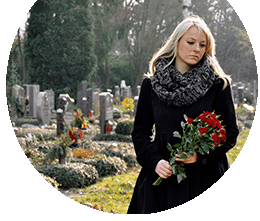
- Attitudes towards dying and death. Loss and grief in life
- People’s range of emotions following a death.
- Symptoms of grief. Physical effects of grief.
- Stages of grief. Kubler–Ross.
- Other grief models.
- The Loss Cycle
- Anticipatory grief.
- Grief resolution.
- Unresolved grief.
- How different cultures view grief. Common myths about grief and the grieving process.
- Complicated feelings. Being conflicted.
- From grief to depression: symptoms.
- Emotions that emerge after death.
- Delay in the grieving process caused by practical issues.
- Dealing with the tragedy of child death
- Who is involved.
- Still birth.
- Death of a neonate
- Death of a child.
- Death of a parent. Grandparent. Pet death.
- Changes in a child’s behaviour. Bed wetting, thumb sucking, withdrawal and other behaviours. How and why children play up after bereavement.
- Helping children deal with death. Talking to a child about death.
- Pre-counselling Fully understanding the nature and issues concerning the child and the death before counselling.
- Involving the child in the funeral.
- Memory box.
- Helping teens.
- Useful books for children.
- Who commits suicide and why.
- Terminology. What the bereaved can say about the death.
- Impact of a suicide note. Impact on the parent.
- Impact on a child. Will the child copy the suicidal act?
- Practical issues: the inquest. Post mortem. Who to notify. The Bereavement Register.
- Joining a support group.
- The widow and widower
- Grief after terminal illness. The impact on the carer.
Recognising the centre in family structure and new roles.
- Widow and widower bereavement.
- Widowed young, widowed in later life. The first few weeks.
- The effect of death on the strong one, the breadwinner, on males.
- Assessment strategies.
- Setting realistic expectations for the client’s grief: duration, impact.
- Helping the client move on.
- Help to understand the mourning process.
- Grief counselling versus grief therapy.
- Writing exercises<
- Journaling.
- Writing a letter to the deceased<
- How the client can help themselves.
- Words of grief
- Strategies for coping.
- Strategies for overcoming depression.
- Registering a death. The undertaker.
- The funeral.
- Adapting and personalising the service.
- Public displays.
- Wearing black. Party or wake.
- Wakes
- Rituals: public and private
- The will. Probate.
- House clearance. Inheritance tax. Selling the house.
- Teachers, medical professionals, social care staff, police and prison staff, work colleagues.
- How professionals can be affected.
- How they can help.
- What to say. What not to say.
- Setting up a private bereavement counselling practice
- location
- Naming your company
- How to advertise and promote your practice.
- Business plan
- Charging
- How to keep the books and manage your money
- Staying within the law.
- Insurance and business structure.
- Book keeping
- Accountants
- Strategic marketing planning
- Advertising and promotion
- Personal selling
- Tips for print media
- Your potential market
- The role and value of listening therapy.
- Active listening
- How to establish a relationship using counselling skills
- Empathy. Non-judgmental interaction. On giving advice.
- The role of silence
- Body language.
- Giving advice
- Prompts
- Terminating a session
- The client: counsellor relationship. Ethical framework
- Referring clients

Speak to
an advisor on
01373
800 815


